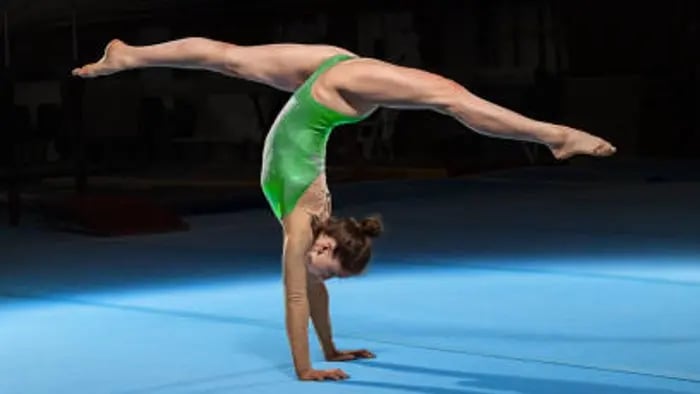- Strength Development
- Flexibility
- Coordination and Balance
- Endurance
- Bone Density
- Posture and Alignment
- Mental Toughness
- Cognitive Development
- Social Development
- Emotional Development
Introduction

Have you ever done amazing flips and twists of gymnasts, defying gravity with moves? Gymnastics is more than just a sport, it is a journey that builds not only physical strength and agility but also boosts mental, emotional, and social well-being. Engaging in gymnastics offers a complete approach to personal growth.
Through gymnastics, kids can develop self-confidence by mastering new skills and overcoming challenges. It teaches discipline, helping kids stay focused and dedicated to their goals. Perseverance becomes second nature as kids practice routines and perfect techniques.
Moreover, gymnastics is a team effort, creating collaboration and teamwork. Kids learn to support and encourage teammates, building strong bonds and friendships.
Beyond the physical benefits, gymnastics nurtures important life skills that can positively impact every aspect of kids' lives. Whether aiming to compete or simply enjoying the thrill of learning new tricks, gymnastics offers a path to self-improvement and personal fulfilment.
Benefits of Gymnastics for Building Physical Resilience

Strength Development
Gymnastics involves a variety of movements that build muscle strength throughout kids’ bodies. From holding steady on the balance beam to swinging on the uneven bars, each activity challenges different muscle groups, promoting overall strength.
Flexibility
Flexibility is crucial in gymnastics. Stretching and performing various body positions and routines help improve kids' flexibility over time. This not only improves kids' gymnastic skills but also reduces the risk of injury in everyday activities.
Coordination and Balance
Gymnastics requires precise coordination and balance. Practicing routines on different apparatus like the floor, beam, and vault improves kids’ ability to control body movements effectively. This coordination translates into better balance, which is essential for overall stability and preventing falls.
Endurance
Gymnastics routines often involve performing sequences of movements repeatedly. This builds endurance, allowing kids to sustain physical activity for longer periods without getting tired easily. Improved endurance also supports cardiovascular health.
Bone Density
Weight-bearing activities like gymnastics help increase bone density, making kids’ bones stronger and less prone to fractures. This is particularly important during childhood and adolescence when bone growth and development are crucial.
Posture and Alignment
Practicing gymnastics promotes proper posture and body alignment. Learning to engage core muscles and maintain a neutral spine position during exercises contributes to spinal health and reduces the risk of back problems later in life.
Mental Toughness
Gymnastics challenges kids mentally as well as physically. Overcoming obstacles, learning new skills, and performing routines under pressure build mental resilience and confidence. These mental skills can be applied to other areas of life, helping kids face challenges with determination and positivity.
Benefits of Gymnastics apart for Physical Resilience

Cognitive Development
- Improved Motor Skills: Gymnastics trains both fine and gross motor skills as children learn to control the body precisely. Balancing on the beam and executing tumbling sequences improve coordination and body awareness.
- Improved Problem-Solving: Learning gymnastics routines requires children to plan and execute movements in sequence, boosting problem-solving skills. They learn to analyze challenges and adjust movements in real time.
- Heightened Concentration: Executing gymnastics maneuvers safely demands intense focus. As children practice routines, they strengthen the ability to concentrate, which can positively impact academic performance.
Social Development
- Teamwork: Gymnastics often involves group activities and routines, creating teamwork and cooperation among children. They learn to collaborate, support each other, and work towards common goals.
- Communication Skills: Children interact with coaches and teammates, improving communication abilities. They learn to listen attentively, follow instructions, and effectively express themselves during training and performances.
- Building Friendships: Gymnastics classes provide opportunities for children to form friendships based on shared experiences and interests. These friendships contribute to a sense of belonging and social support.
Emotional Development
- Self-Confidence: Mastering gymnastics skills and achieving personal goals boosts children’s self-confidence. Overcoming challenges and witnessing progress improves self-belief and a sense of accomplishment.
- Perseverance: Gymnastics teaches children to persevere through setbacks and challenges. They learn to embrace difficulties as opportunities for growth, developing resilience and determination.
- Emotional Regulation: Gymnastics provides a structured environment where children can express and manage emotions. They learn to regulate feelings positively, navigating the emotional highs and lows of training and competitions.
Conclusion

Gymnastics offers a complete approach to children's development, shaping not only physical abilities but also cognitive, social, and emotional skills. Whether they aspire to compete or simply enjoy the sport, gymnastics equips children with valuable tools for success in all aspects of life.
Tarishi Shrivastava is a young writer who has covered a range of topics on children's health, including nutrition, fitness, sleep, and parent-child bonding. With a keen interest in simplifying wellness for parents, she brings a practical and engaging approach to her writing. Beyond work, she enjoys exploring new ideas, staying curious, and creating meaningful content.
The views expressed are that of the expert alone.
The information provided in this content is for informational purposes only and should not be considered a substitute for professional medical advice, diagnosis, or treatment. Always seek the advice of your physician or another qualified healthcare provider before making any significant changes to your diet, exercise, or medication routines.
References
https://reachgymnastics.com/how-gymnastics-builds-more-than-just-physical-strength/
https://www.swlgymnastics.co.uk/the-benefits-of-gymnastics-for-early-childhood-development










